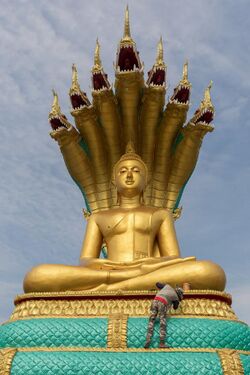Philosophy:Adhiṭṭhāna
| Part of a series on |
| Theravāda Buddhism |
|---|
 |
| |||||||||||||||||||||||||||||||||||||||||||
Script error: The function "transl" does not exist. (Pali; from Script error: The function "transl" does not exist. meaning "foundational" or "beginning" plus Script error: The function "transl" does not exist. meaning "standing"; Sanskrit, अधिष्ठान) has been translated as "decision," "resolution," "self-determination," "will",[1] "strong determination"[2] and "resolute determination."[3] In the late canonical literature of Theravada Buddhism, Script error: The function "transl" does not exist. is one of the ten "perfections" (Script error: The function "transl" does not exist.), exemplified by the bodhisatta's resolve to become fully awakened.
Pāli Canon texts
While Script error: The function "transl" does not exist. appears sporadically in the early Pāli Canon, various late-canonical and post-canonical accounts of the Gautama Buddha's past lives clearly contextualize Script error: The function "transl" does not exist. within the Theravadin ten perfections.
Digha Nikaya analysis
In the Pali Canon, in the Dīgha Nikāya discourse entitled, "Chanting Together" (DN 33), Sariputta states that the Buddha identified the following:
- Four kinds of resolve (Script error: The function "transl" does not exist.): [to gain] (a) wisdom, (b) truth (sacca), (c) relinquishment (Script error: The function "transl" does not exist.), (d) tranquility (Script error: The function "transl" does not exist.).[4]
Bodhisatta Sumedho
In the late-canonical Buddhavamsa, the Bodhisatta Sumedha declares (represented in English and Pali):
|
And as a mountain, a rock, stable and firmly based, |
Script error: The function "transl" does not exist.[6] |
Temiya the Wise
In the late-canonical Cariyapitaka, there is one account explicitly exemplifying Script error: The function "transl" does not exist., that of "Temiya the Wise" (Cp III.6, Script error: The function "transl" does not exist.). In this account, at an early age Temiya, sole heir to a throne, recalls a past life in purgatory (Script error: The function "transl" does not exist.) and thus asks for release (Script error: The function "transl" does not exist.). In response, a compassionate Script error: The function "transl" does not exist. advises Temiya to act unintelligent and foolish and to allow himself to be an object of people's scorn.[7] Understanding the Script error: The function "transl" does not exist.'s virtuous intent, Temiya agrees to this and acts as if mute, deaf, and crippled. Seeing these behaviors but finding no physiological basis for them, priests, generals and countrymen decry Temiya as "inauspicious" and plan to have Temiya cast out. When Temiya is sixteen years old, he is ceremonially anointed and then buried in a pit. The account concludes:
- ... I did not break that resolute determination which was for the sake of Awakening itself. Mother and father were not disagreeable to me and nor was self disagreeable to me. Omniscience [Script error: The function "transl" does not exist.] was dear to me, therefore I resolutely determined on that itself. Resolutely determining on those factors I lived for sixteen years. There was no one equal to me in resolute determination — this was my perfection of Resolute Determination.[8]
See also
- Script error: The function "transl" does not exist. (perfection)
- Script error: The function "transl" does not exist. (wisdom)
- Script error: The function "transl" does not exist. (truth)
- Script error: The function "transl" does not exist. (generosity)
- Script error: The function "transl" does not exist. (tranquillity)
- Script error: The function "transl" does not exist. (renunciation)
- Script error: The function "transl" does not exist. (equanimity)
- Script error: The function "transl" does not exist. (patience)
- Script error: The function "transl" does not exist. (loving-kindness)
- Script error: The function "transl" does not exist. (diligence)
Notes
- ↑ "Script error: The function "transl" does not exist.". The Pali Text Society's Pali–English Dictionary. Chipstead: Pali Text Society. 1921–25. p. 28. https://dsal.uchicago.edu/cgi-bin/app/pali_query.py?qs=adhi%E1%B9%AD%E1%B9%ADh%C4%81na&searchhws=yes&matchtype=exact. As further noted in Rhys Davids & Stede, in the Pali Canon, Script error: The function "transl" does not exist. can at times be wrongly motivated, connoting "obstinancy," as indicated by the Pali phrase Script error: The function "transl" does not exist., "obstinacy, prejudice and bias" (p. 44, "Script error: The function "transl" does not exist.").
- ↑ Goenka, S.N. (1995). The Discourse Summaries. Vipassana Research Publications. p. 72.
- ↑ The Minor Anthologies of the Pali Canon (Part III): 'Chronicle of Buddhas' (Buddhavamsa) and 'Basket of Conduct' (Cariyapitaka). Oxford: Pali Text Society. 1975. passim. ISBN 0-86013-072-X.
- ↑ DN 33 1.11(27), translation by Walshe (1995), p. 492, v. 27. Parenthesized Pali and square-bracketed English are in the original.
- ↑ Buddhavamsa IIA.154-5 (trans. Horner, "Buddhavamsa," p. 22).
- ↑ "Buddhavamsa". II.153-4. http://www.bodhgayanews.net/tipitaka.php?title=&record=10522.
- ↑ Horner (2000), p. 36 n. 5, comments: "Kings, having to be very harsh, accumulated much demerit leading to Niraya [a Buddhist hell realm]."
- ↑ For the whole account, see Horner (2000), pp. 36-38. The final quotation is from Horner (2000), pp. 37-38, vv. 17-19.
Sources
- The Minor Anthologies of the Pali Canon (Part III): 'Chronicle of Buddhas' (Buddhavamsa) and 'Basket of Conduct' (Cariyapitaka). Oxford: Pali Text Society. 2000. ISBN 0-86013-072-X.
- The Pali Text Society's Pali–English Dictionary. Chipstead: Pali Text Society. 1921–25. A general on-line search engine for the PED is available at http://dsal.uchicago.edu/dictionaries/pali/.
- The Long Discourses of the Buddha: A Translation of the Digha Nikaya. Boston: Wisdom Publications. 1995. ISBN 0-86171-103-3.
External links
- "Adhitthana". https://www.dhammawiki.com/index.php?title=Adhitthana.
- "Sangiti Sutta". http://www.buddhistinformation.com/ida_b_wells_memorial_sutra_library/sangiti_sutta.htm. DN 33 in the Ida B. Wells on-line library.
- "Anumodana & Aditthana Paramita: Dedication of Merits & Aspiration Parami". https://www.dhammatalks.net/anumodana_aditthana.htm. (samples)
 |


